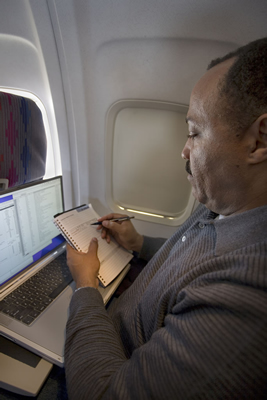|
|
|
|
|
Executive Self-awareness:
Addressing blindspots effectively
|
|
|
|
|
|  Issues with 360s
While many leaders and executives develop a working knowledge of their own style and strengths, unfortunately many fail to fully appreciate the impact of personal characteristics when in an executive role. This, and other factors, can easily lead to blindspots. At best, this can render the executive less than 100% effective. At worst, it can result in poor decision-making, relationship failures, and questionable behavior.
While multi-rater assessments (360s) can provide this much needed insight, otherwise smart, savvy leaders too often dismiss (or minimize, rationalize) the data in these reports. Because 360 processes have been shown to suffer from a handful of biases, the decision to ignore, or simply just fail to act on, their 360 results can be, in fact, completely appropriate.
A few of these biases from I/O research include:
- "Halo" effect - ratings impacted by belief that the executive can do no wrong
- "Recency" bias - ratings impacted by a recent event, positive or negative
- Time - rating inaccuracy based on limited exposure to participant/executive
So, beyond a dismissed 360 (or a significant and costly derailing event), what can be done to enhance executive self-awareness?
|
| |
SOLUTION:
A RIGOROUS, REPUTABLE, SCIENTIFIC SELF-ASSESSMENT PROCESS
|
|  Self-directed Self-directed
By participating in a self-assessment process, an executive has complete control over the data input since he/she is the only person entering data.
It is critical to recognize that sophisticated self-assessment tools simply don't "add up" answers, but compare the participant's overall style of responses to thousands of other respondents. This yields results that are often quite surprising, as the reports frequently pinpoint traits and behaviors that are not included in the questionnaire.
Professionally reputable assessment questionnaires are usually difficult to "game." Additionally, a good assessment will determine any "faking good" or "faking bad," thus eliminating concerns about an executive not being honest with oneself.
The more an executive is able to control the assessment process (given typical executive desires for control), the more likely it is that the results and feedback will be taken seriously.
|
|
 |
A sampling of self-assessment measurements:
|
Hardwired Traits
- Emotional stability
- Interpersonal sensitivity
- Openness
Emotional Intelligence - Empathy
- Stress tolerance
- Impulsivity
Challenges & Derailers
- Risk aversion
- False confidence
- Inconsistent focus
Values/Motivators
- Tradition
- Science
- Recognition
|
|
Executive self-assessment is utilized when there is a:
| |
- Transition
- Loss of passion or focus
- Career "fork in the road"
- Development standstill
- Pattern of self-destructive behavior(s)
- Significant change in role
|
|
|
|  Convenient Convenient
Like any other development project offered to executives, time and effort must be considered very carefully prior to implementation.
Many reputable self-assessment questionnaires can be completed in less than 15 minutes each, using on-line input. In addition to providing increased convenience, executives and other leaders can complete self-assessments from home to limit distractions and maximize thoughtful responses.
Assessment summary reports are provided via e-mail, and in-depth analysis and feedback can be delivered by teleconference. For some executives, the anonymity provided by on-line questionnaires and telephone interactions affords a more honest, direct conversation about personality traits, motivators, career decisions, and blindspots.
|
|  A few words about precision A few words about precision
Too many commercially available self-assessment tools promise much more than they actually deliver. Its critical to "assess the assessment" by keeping in mind the following:
1. Does the vendor have a technical manual that is readily available (this is a standard requirement for test publishers who adhere to professional guidelines)
2. Has the assessment been peer reviewed and is that review available? (a hint: go to the Buros Center for Testing to check up on your test publisher or consultant's claims)
3. Ask what professional guidelines (specifically, issued by which organizations or government task forces) were followed in the creation and validation of the assessment. Your consultant/test publisher should be able to answer this easily and confidently or get you this information quickly.
|
|
|
A self-assessment process can be a precursor to coaching, a periodic "tune-up," or can simply help move an executive forward by providing an accurate and clear mirror of their traits, behaviors, and potential challenges. By giving executives control over their data collection through self-assessment, development strategies or key professional decisions will be implemented with significantly increased personal commitment and thus, perceived and real value.
Sincerely,
|
Michael Klein, PsyD MK Insights LLC 413-320-4664 Click here to request more information
|
|
Dr. Michael Klein holds a doctorate in clinical psychology and specializes in the use of behavioral tools for individuals in business and corporate settings. Michael is a member of the American Psychological Association (APA) and Society for Industrial & Organizational Psychology (SIOP).
|
|
|
|
|
|